After acquiring SanDisk and introducing WD Green and WD Blue SSDs, it is no surprise to see Western Digital introduce a WD Black SSD that is a M.2 PCIe drive. In keeping with SanDisk’s recent trends for mainstream consumer SSDs, the WD Black uses a Marvell controller (the 88SS1093, also seen in the Plextor M8Pe) and uses SanDisk’s 15nm TLC NAND flash. And yes, the blue PCB is another SanDisk hallmark, even though it clashes with Western Digital’s branding for the drive.
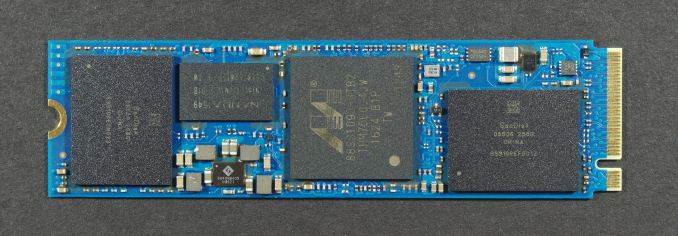
Western Digital and SanDisk are relatively late in bringing a consumer NVMe SSD to market. They’re clearly intending for the WD Black SSD to be a fairly mainstream product by using TLC NAND and pricing it below high-end SATA SSDs. In the SATA space SanDisk has made very effective use of their planar TLC and the SanDisk X400 and WD Blue are the best in their class. Having taken their time developing the WD Black, we expect another solid performer. However, time is running out for planar TLC the WD Black may turn out to be a short-lived product before being replaced by a successor with 3D NAND. All four major NAND manufacturers plan to ship 64+ layer 3D NAND this year with TLC parts up to 512Gb, and if things go according to plan for at least two or three of them we should see the NAND shortage start to fade and prices and capacities improve.
| WD Black PCIe SSD Series Specifications | |||
| Capacity | 256GB | 512GB | |
| Form Factor | M.2 2280 | ||
| Interface | PCIe 3.0 x4 NVMe | ||
| Controller | Marvell 88SS1093 | ||
| NAND | SanDisk 15nm TLC | ||
| Sequential Read | 2050 MB/s | ||
| Sequential Write | 700 MB/s | 800 MB/s | |
| Random Read (4 KB) IOPS | 170k | 170k | |
| Random Write (4 KB) IOPS | 130k | 134k | |
| Power | Peak | 8.25 W | |
| Idle | 5.5 mW | ||
| Endurance | 80 TBW | 160 TBW | |
| Encryption | none | ||
| Warranty | 5 years | ||
| MSRP | $109 | $199.99 | |
The WD Black comes in only the two capacities that should be most popular: 256GB and 512GB. A 128GB PCIe SSD risks squandering much of the advantage of the faster interface due to the low number of NAND dies being a bottleneck, and 1TB PCIe SSDs are still expensive enough to be substantially less popular. A 1TB version would also need to be a double-sided M.2 module, which would limit compatibility with some laptops. As expected for a TLC SSD, the rated read performance is much higher than the write performance, though Western Digital does still give the WD Black a very nice looking random write rating. The endurance ratings for the WD Black are a little lower than I’d like to see given that even a TLC-based PCIe SSD is something of a premium product, but the five year warranty is quite reasonable.
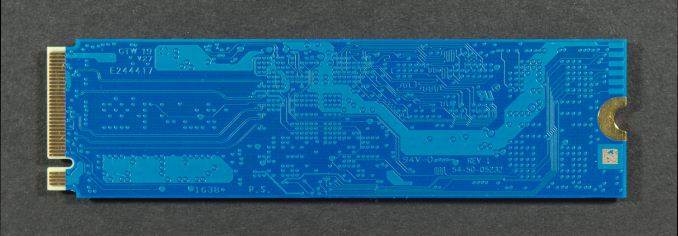
Western Digital is currently taking pre-orders for the WD Black at MSRP and projecting a ship date of March 14, while there are already some third-party Amazon sellers offering it above MSRP. The MSRPs are about 10% higher than the current prices for the Intel SSD 600p, the current cheapest and slowest PCIe SSD.
For this review we will be comparing the 512GB WD Black primarily against other PCIe SSDs of similar capacity, and against a handful of the better SATA SSDs currently on the market. Some specific competitors to keep an eye on:
- The Plextor M8Pe uses the same Marvell controller and Toshiba’s 15nm MLC counterpart to the 15nm TLC used by the WD Black.
- The WD Blue uses the same NAND as the WD Black, but a Marvell SATA SSD controller instead of the PCIe NVMe controller.
- The Intel SSD 600p based on Intel 3D TLC NAND and Silicon Motion’s SM2260 controller is currently the cheapest and slowest NVMe SSD.
- The Samsung 960 EVO is the TLC PCIe SSD that’s positioned above the WD Black in the market, and is the more mainstream of Samsung’s current NVMe offerings.
| AnandTech 2015 SSD Test System | |
| CPU | Intel Core i7-4770K running at 3.5GHz (Turbo & EIST enabled, C-states disabled) |
| Motherboard | ASUS Z97 Pro (BIOS 2702) |
| Chipset | Intel Z97 |
| Memory | Corsair Vengeance DDR3-1866 2x8GB (9-10-9-27 2T) |
| Graphics | Intel HD Graphics 4600 |
| Desktop Resolution | 1920 x 1200 |
| OS | Windows 8.1 x64 |
- Thanks to Intel for the Core i7-4770K CPU
- Thanks to ASUS for the Z97 Deluxe motherboard
- Thanks to Corsair for the Vengeance 16GB DDR3-1866 DRAM kit, RM750 power supply, Carbide 200R case, and Hydro H60 CPU cooler
Our performance consistency test explores the extent to which a drive can reliably sustain performance during a long-duration random write test. Specifications for consumer drives typically list peak performance numbers only attainable in ideal conditions. The performance in a worst-case scenario can be drastically different as over the course of a long test drives can run out of spare area, have to start performing garbage collection, and sometimes even reach power or thermal limits.
In addition to an overall decline in performance, a long test can show patterns in how performance varies on shorter timescales. Some drives will exhibit very little variance in performance from second to second, while others will show massive drops in performance during each garbage collection cycle but otherwise maintain good performance, and others show constantly wide variance. If a drive periodically slows to hard drive levels of performance, it may feel slow to use even if its overall average performance is very high.
To maximally stress the drive’s controller and force it to perform garbage collection and wear leveling, this test conducts 4kB random writes with a queue depth of 32. The drive is filled before the start of the test, and the test duration is one hour. Any spare area will be exhausted early in the test and by the end of the hour even the largest drives with the most overprovisioning will have reached a steady state. We use the last 400 seconds of the test to score the drive both on steady-state average writes per second and on its performance divided by the standard deviation.
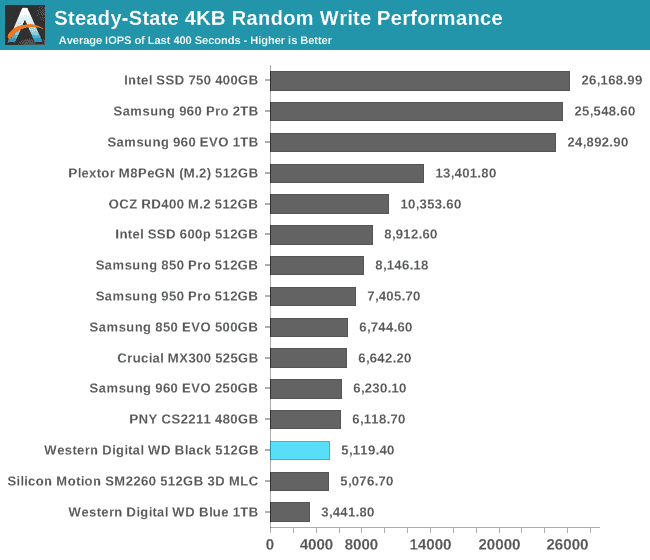
The WD Black has a respectable steady-state random write speed for a drive with planar TLC NAND, but the drives with 3D TLC are all faster. The Plextor M8Pe using the same controller but MLC is more than twice as fast. The SATA-based WD Blue that uses the same NAND is substantially slower despite having twice the capacity.
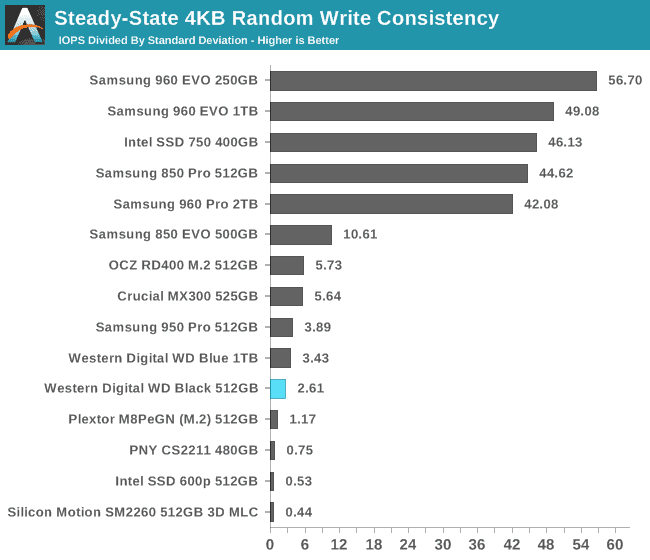
The WD Black’s consistency score isn’t in the gutter and is actually more than twice the Plextor M8Pe’s score, but it’s still far below the scores of the drives that are both fast and steady.
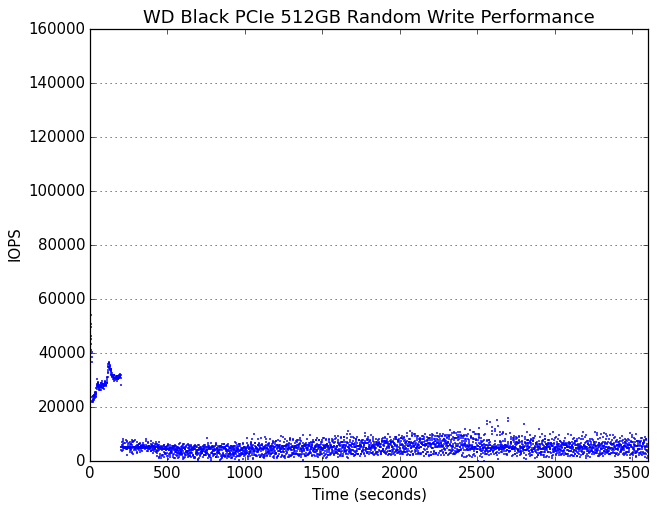 |
|||||||||
| Default | |||||||||
| 25% Over-Provisioning | |||||||||
The WD Black runs out of spare area about four minutes into the test and abruptly transitions to its steady state. The performance consistency gets gradually worse over the course of the test but the average stays the same. With extra overprovisioning, the WD Black hovers around 33k IOPS with good consistency before transitioning to steady state.
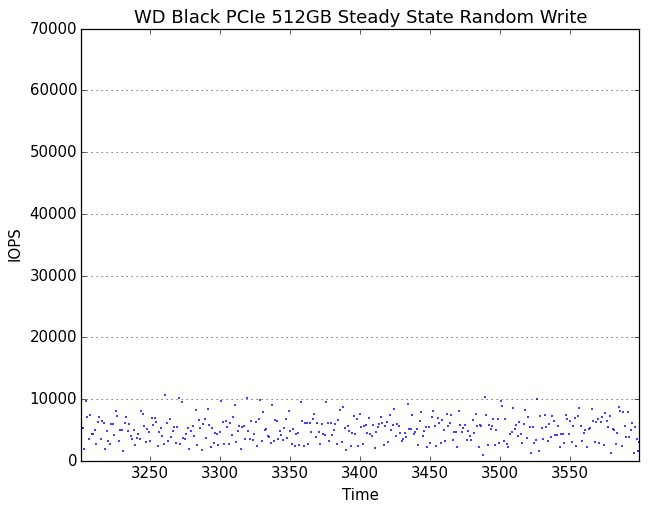 |
|||||||||
| Default | |||||||||
| 25% Over-Provisioning | |||||||||
By the end of the test, the WD Black’s steady state performance is varying from just under 1k IOPS to just over 10k IOPS. With extra overprovisioning, the WD Black is mostly staying between 10k and 30k IOPS.
The Destroyer is an extremely long test replicating the access patterns of very IO-intensive desktop usage. A detailed breakdown can be found in this article. Like real-world usage and unlike our Iometer tests, the drives do get the occasional break that allows for some background garbage collection and flushing caches, but those idle times are limited to 25ms so that it doesn’t take all week to run the test.
We quantify performance on this test by reporting the drive’s average data throughput, a few data points about its latency, and the total energy used by the drive over the course of the test.
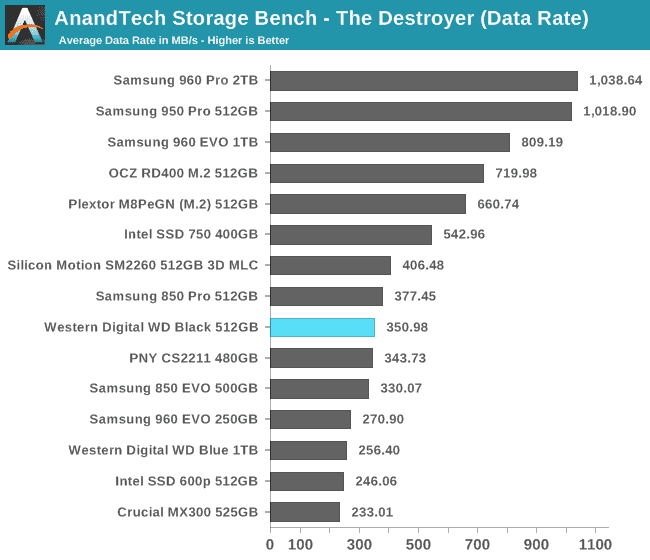
The WD Black’s average data rate on The Destroyer is a little bit slower than the fastest SATA SSD of comparable capacity, and much faster than the Intel 600p. The Samsung 960 EVO is the only TLC-based SSD we’ve tested that outperforms the WD Black.
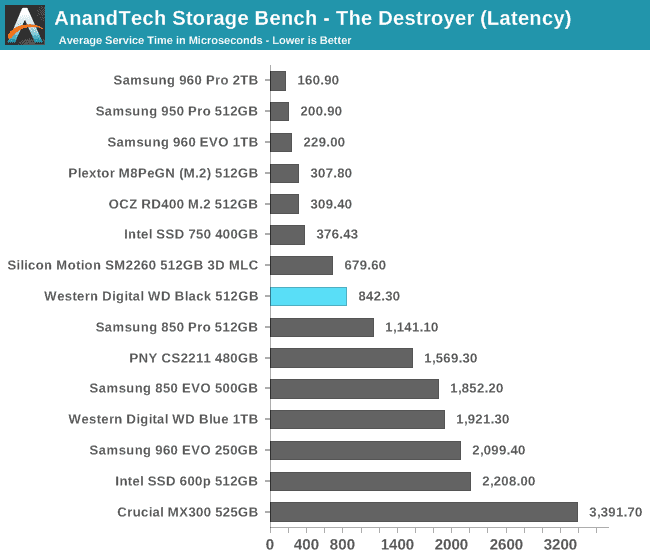
While the WD Black’s average data rate didn’t quite beat the best SATA SSDs, its average service time is substantially better than the Samsung 850 PRO, though nowhere close to most MLC PCIe SSDs.
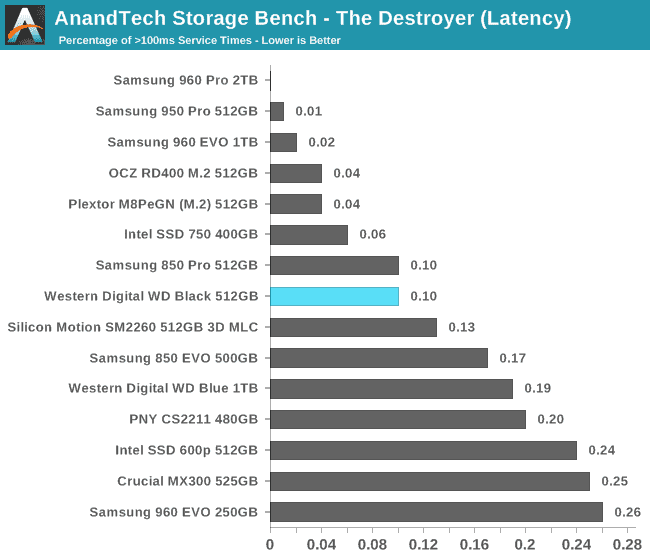
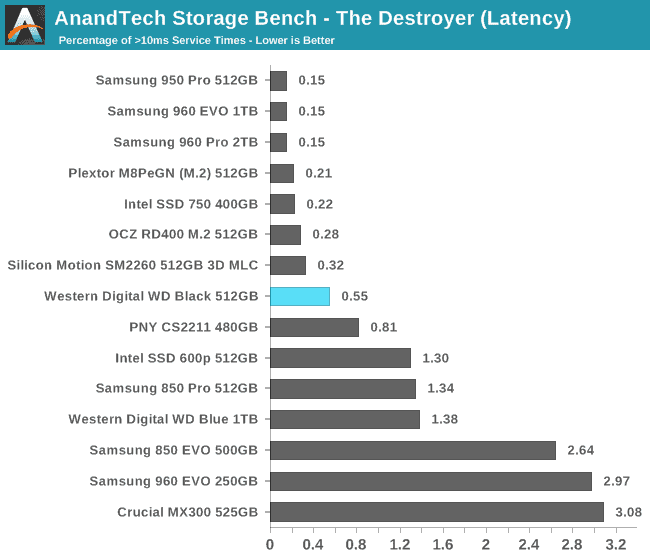
The WD Black is no better than the Samsung 850 PRO at avoiding high-latency outliers above 100ms, but the WD Black has a significant advantage over all SATA SSDs at the 10ms threshold.
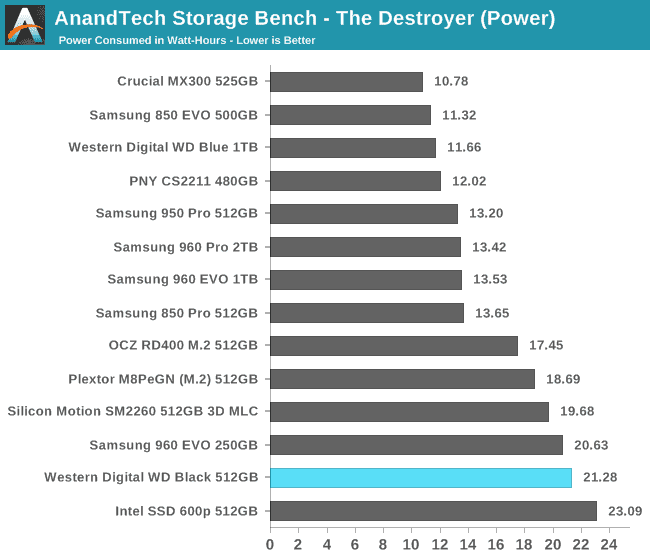
The WD Black’s power efficiency during The Destroyer is poor, with total energy usage that is higher than almost all of its competitors.
Our Heavy storage benchmark is proportionally more write-heavy than The Destroyer, but much shorter overall. The total writes in the Heavy test aren’t enough to fill the drive, so performance never drops down to steady state. This test is far more representative of a power user’s day to day usage, and is heavily influenced by the drive’s peak performance. The Heavy workload test details can be found here.
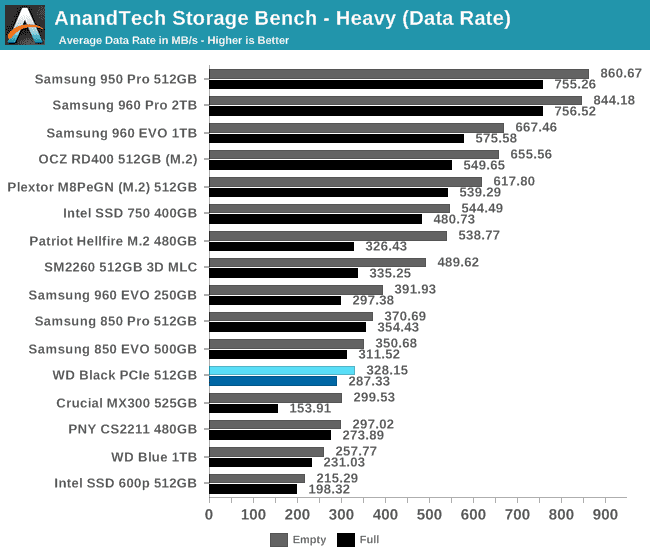
As with The Destroyer, the WD Black’s average data rate on the Heavy test is not beyond the reach of the very best SATA SSDs, but it is faster than most SATA SSDs, including the WD Blue. The WD Black also handles the pressure of a full drive better than many TLC SSDs and suffers relatively less performance drop than even some MLC-based PCIe SSDs like the Patriot Hellfire.
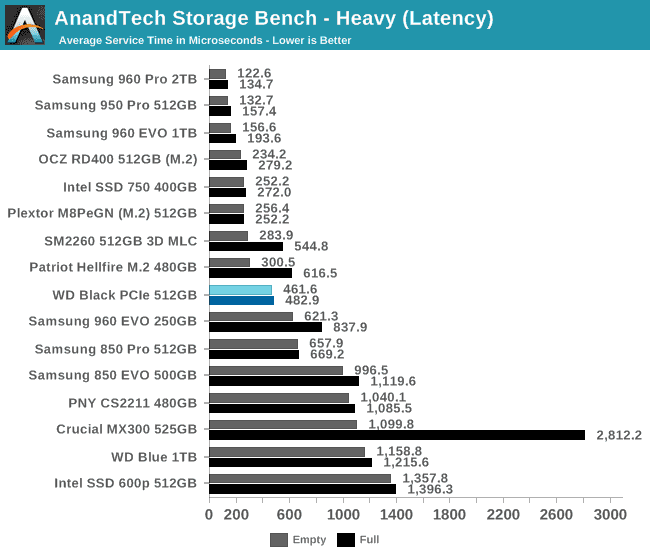
The average service time delivered by the WD Black scores in the low end of the range for PCIe SSDs but it is clearly better any SATA SSD. Once again the impact of running the test on a completely full drive is minimal.
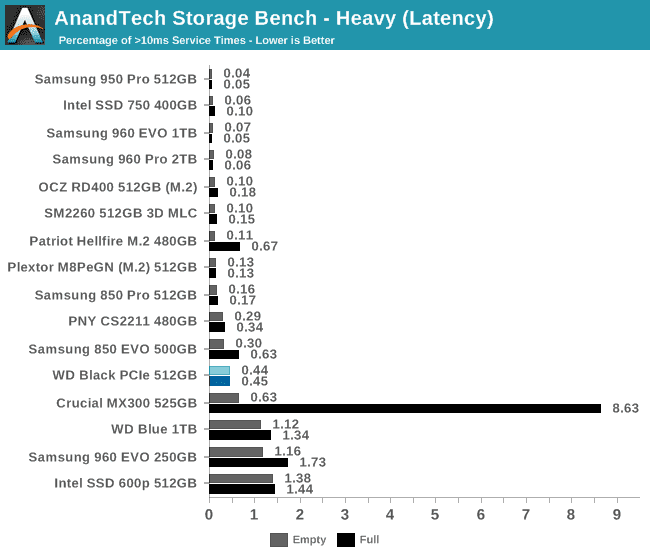
The WD Black suffers from more high-latency operations over the course of the Heavy test than several SATA SSDs, but it ranks better than most budget TLC SSDs.
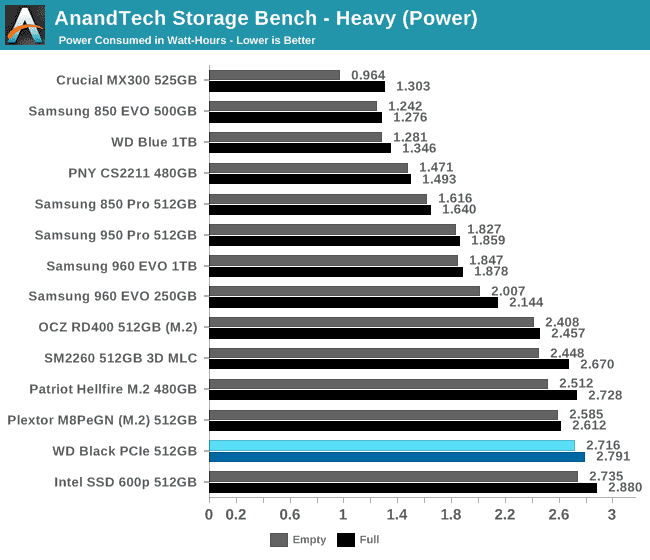
The WD Black’s power efficiency during the Heavy test is only slightly better than the Intel SSD 600p. All of its MLC-based competition is at least a little bit more efficient, and Samsung’s PCIe SSDs are much more efficient.
Our Light storage test has relatively more…







